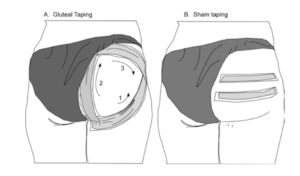by Mitch Hauschildt, MA, ATC, CSCS
I want to be very clear up front as I roll into this blog post that I don’t treat stroke patients, nor do I consider myself any sort of an expert on them. I do often get asked about taping stroke patients when I teach Rocktape courses because we typically get a lot of physical therapists who treat a variety of patients and conditions. While I don’t treat stroke patients, I do understand the human body well and can offer some ideas and insight into a number of conditions that I don’t typically treat.
Strokes are obviously difficult and debilitating and require weeks, months or even years of therapy to recover from. They can be frustrating for the patient and therapist alike. Because I get a lot of questions regarding taping for strokes, I was definitely interested when I saw an article supporting the use of taping to improve gait for stroke patients.
Because strokes have such an impact on the nervous system, I do think that taping can play a major role in their therapy process because much of what we do with kinesiology taping is neurologically driven. What makes the condition difficult is that no 2 stroke patients are alike. There is a wide variety of symptoms and dysfunctions that accompany a stroke due the varying degrees of severity and locations that can happen with a stroke. This makes for a challenging treatment process for clinicians working with stroke patients.
My initial recommendation for clinicians who work with stroke patients is to start with postural corrections because postural taping does a great job of improving joint centration which leads to immediate improvements in movement patterns that can be trained effectively with low threshold-high repetition strategies.
In this study, entitled “Gluteal taping improves hip extension during stance phase of walking following stroke”, they compared a gluteal taping group to a non taping group and a sham taping technique and found significant improvement in hip extension and postural position during several different speeds of walking by stroke patients.
The author states that “Gluteal taping led to an immediate improvement in hip extension at the end of single support, with a concomitant small increase in step length on the unaffected side.” They then went on to say that “…the fact that the trunk was more upright in the taped condition suggests that they subjects may have been better able to utilize inner range hip extensor muscle activity and that their pelvis was more stable over the thigh.” They also concluded that the improvement in hip extension was due to an improvement in “true” hip extension and not simply an increase in pelvic anterior rotation.
These remarks indicate that if we improve joint centration and posture, that we can improve stability, mobility and ultimately movement, even with stroke patients. Thus, we can use tape to improve movement quality so then we can lock it in with repetition. Understand that with a patient with a compromised neuromuscular system (such as a stroke), it will be more challenging to do this than with a healthier patient, so the quality improvements may come in smaller doses and it may take more repetition to lock it in permanently.
Move well, then move often.
Some potential limitations that exist in this study are that the subjects were all relatively high functioning in that they had to have had a stroke, but in order to qualify for the study, they had to be able to ambulate independently without assistance prior to being included in the study. So, the effectiveness of such a technique on more disabled patients may or may not be as effective.
If you want to read the research for yourself, follow the link here.
Overall, I haven’t seen a ton of research on taping for stroke patients, so this is definitely a good start. At the end of the day, I enjoy reading research and what we do every day has to be grounded in research, but what is most important to me is whether the people who are standing in front of me are better when they walk out of my facility as compared to when they walked in. If they improve, then I’m doing well. Use the test and retest model with your patients, regardless of your setting or patient population to guide your treatments and interventions.



This is great! Thank you for sharing, Mitch! My father suffered a stroke 18 months ago and has since been diagnosed with Parkinson’s disease. I’ll be taping him tomorrow. Every little gain or delay in progression is huge! Thanks again for sharing the good news!